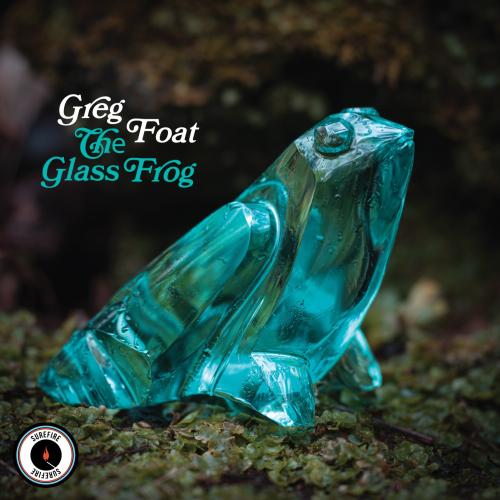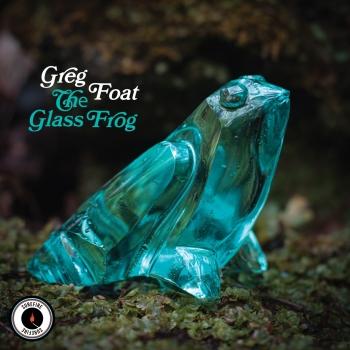
The Glass Frog (Library Edits) Greg Foat
- 1 Sea of Tranquility (Library Edit) 04:12
- 2 The Glass Frog (Library Edit) 04:19
- 3 Foals of Epona (Library Edit) 04:13
- 4 Movilinium (Library Edit) 04:41
- 5 My Love Has Green Eyes (Library Edit) 03:53
- 6 Sea of Tranquility (Library Edit: Underscore) 04:12
- 7 The Glass Frog (Library Edit: Underscore) 04:18
- 8 Foals of Epona (Library Edit: Underscore) 04:13
- 9 Movilinium (Library Edit: Underscore) 04:13
- 10 My Love Has Green Eyes (Library Edit: Underscore) 03:52
Info zu The Glass Frog (Library Edits)
The Glass Frog von Greg Foat, erschienen bei Blue Crystal Records, ist eine sublime Mischung aus sanftem Jazz und spacigen, euphorischen Atmosphären. Foat glänzt zeitweise als Hauptdarsteller, während die Band ihn perfekt ergänzt und das ganze Album über eine entspannte Stimmung verbreitet.
Zu den Höhepunkten gehört "Sea Of Tranquility", ein stimmungsvolles Bläser-Wiegenlied, das Space Jazz vom Feinsten verkörpert. Foals Of Epona" bietet eine beruhigende Jazzband mit einem funkigen Schlagzeuger, der einen herrlichen Groove erzeugt. Clusters" bringt eine nostalgische 60er-Jahre-Jazz-Atmosphäre mit sich und hüllt den Hörer in seine reiche Klangwelt ein. Das herausragende Stück "My Love Has Green Eyes" zeigt eine großartige Saxophonarbeit mit wunderschönen Tasten, die die komplexe Mischung der Band noch verstärken.
"Greg Foat bringt den Jazz an Orte, an denen die Genres keine Rolle mehr spielen und die Musik um ihrer selbst willen aufsteigt." (Ian Rankin)
Greg Foat ist einer der führenden Jazzpianisten, Komponisten und Musikproduzenten Großbritanniens.
Greg hat mit einer Vielzahl von Musikern zusammengearbeitet, darunter Bob Lind, Moses Boyd, Curtis Lundy, Rita Ora, Wendy James, Questlove und The Kooks. In den letzten Jahren hat er für Jazzman Records, Athens Of The North und Strut aufgenommen.
Greg Foats neueste Veröffentlichung "The Glass Frog" bietet einen üppigen Wandteppich aus Jazz- und Ambient-Soundscapes. Die Verschmelzung von Vintage-Synthesizern mit komplexen Kompositionen zeigt Foats sich entwickelnde Kunstfertigkeit.
The Glass Frog ist ein fantastisches Album für Gelegenheits- und Hardcore-Jazzfans, das eine perfekte Mischung aus sanften, funkigen und atmosphärischen Jazz-Elementen bietet. Greg beeindruckt weiterhin.
Greg Foat
Greg Foat
One of the UK’s leading jazz pianists, composers and producers, Greg Foat’s music is heavily influenced by the forward-thinking pioneers of British jazz during the ‘60s and ‘70s including Gordon Beck, Stan Tracey, Michael Garrick and Graham Collier as well as European composers like Piero Piccioni, Ennio Morricone, Michel Legrand and Vangelis. He has recorded prolifically in recent years for Jazzman Records, Athens Of The North and, most recently, for Strut, switching effortlessly from soul-jazz fusions to cinematic, haunting compositions, pastoral acid folk and electronic soundscapes. He has also played gigs and recording sessions all over the world with a diverse range of A-list artists including FKA Twigs, Questlove, Bob Lind, Curtis Lundy and Wendy James.
Foat first learned his craft at his home town of Ventnor on Isle Of Wight. “I love the island and it was a beautiful place to grow up for me. I was 10 when I asked my parents for a piano and my Dad bought me an old upright. My piano teacher gave me a simple blues to learn and I began to improvise from that and write my own music. A few years later, Jeff Clyne and Trevor Tomkins came to my school to run a jazz workshop. Jeff had recorded a brilliant album with Gordon Beck called ‘Experiments With Pop’ and he sent me the cassette with that album and ‘Gyroscope’. I loved Gordon’s playing and he became my greatest influence. He was always very kind to me; I went to visit him a few times during my mid-20s and he taught me a lot – I even went to Paris with him and watched him slay other groups on stage. He was just an incredible musician. After that, I joined the Isle Of Wight County Youth Jazz Orchestra which was a great training ground for the island’s musicians.” Foat continued to cut his teeth on piano by sitting in with some of the retired jazz musicians on the island that had played on the cruise ships that came through the Solent from the ‘60s to the ‘80s.
However, before becoming a renowned musician, Foat first carved a reputation as a DJ, now hosting a regular show on London’s Soho Radio and playing occasional club sets. “I own over 1000 albums and a few hundred 45s and have collected vinyl since I was 11 years old. I would go and hunt out the sounds I wanted in old second-hand record stores and charity shops on the Isle of Wight. When I moved to London and started DJing in 1997, you were expected to play original vinyl and no reissues! So, I really had to expand my record collection. I have played clubs in New York, Miami and L.A and I have had regular gigs in Stockholm, Paris and Cannes.
As a pianist, Foat’s unique approach to the instrument soon led to tours and recordings with leading musicians during the early 2000s. “My first session was for Emma Nilsdotter in Gothenburg in 2001 for Universal Music – we recorded at Mattias Glava’s analogue studio,” remembers Foat. “She was also a demo singer for Britney Spears at that point.” Later sessions included singer / songwriter Bob Lind, Questlove from The Roots and The Kooks (on their ‘Let’s Go Sunshine’ album and ‘Pressure’ single) and a tour across Europe and Scandinavia with Transvision Vamp’s Wendy James. “I also had a residency at the Faena Hotel in Miami,” remembers Foat. “and various people jumped up to guest – I had Rita Ora serenading Lewis Hamilton with ‘You Make Me Feel Like A Natural Woman’, FKA Twigs sang with us and Curtis Lundy depped for my bass player when he couldn’t make a gig!”
He recorded his first album under his own name in 2011 for Jazzman with the ‘Dark Is The Sun’ album, an imaginary soundtrack to Philip Jose Farmer’s book of the same name. The recording started a long-standing relationship with musicians that have played with Foat for over 10 years including Eric Young (congas), Rob Mach (tenor sax) and Trevor Walker (fluegelhorn). Foat returned to Mattias Glava in Gothenburg who has since consistently soundtracked and mixed Foat’s recordings. “Mattias is an incredible engineer and has one of the finest analogue studios in the world - the Neve console he used on this album used to belong to Donald Fagen.” ‘Dark Is The Sun’ also served as a template for Foat’s freeform methods in constructing his albums: “The creative process for me can be haphazard. Sometimes I go into the studio with a fully written and arranged piece that I have been working on for months which may or may not work, other times I go in with a vague idea and improvise with the musicians and it gradually becomes fully formed.” The album was nominated for Best Album at Gilles Peterson’s Worldwide Awards in 2011.
“Greg Foat continues to sonically map fictional lunar panoramas from a coterie of well-thumbed sci-fi paperbacks.” God Is In The TV
A year later, Foat turned inward with a meditative collection of instrumentals on his sophomore album ‘Girl And Robot With Flowers’ (Jazzman). Again inspired by futuristic authors (in this case Brian Aldiss, Robert Heinlein and Roger Zelazny), the core of the album was based around an Aldiss short story which found the author himself wracked with anxiety and self-doubt over his latest fictional tale. The plaintive tone echoed Foat’s own life at the time, “I remember being quite heartbroken after splitting up with my girlfriend so the whole album is tinged with that sadness.”
“Foat’s third truly excellent album effortlessly injects the life and soul back into contemporary jazz.” All About Jazz
In 2014, Foat was looking outwards, enjoying a long-standing residency at the Playboy Club in London’s Mayfair and embarking on the first live recording recorded at the club for over forty years. Foat’s many musical influences shone through: 1960s British jazz, of course, on Tubby Hayes’ ‘Finky Minky’ but also library composition on covers of Keith Mansfield’s classic ‘Funky Fanfare’ and Alan Hawkshaw and John Rostill’s ‘Madrid’, even post-punk on a fluid version of Pigbag’s ‘Papa’s Got A Brand New Pig Bag’. The album cemented Foat’s reputation as one of the UK’s most adept, versatile players.
For his final two albums for Jazzman, Foat would return to more reflective territory. 2015’s ‘The Dancers At The Edge Of Time’ took Foat back to the Isle Of Wight for a memorable recording in Saint Catherine’s Church in his hometown of Ventnor, again inspired by literature and the polymath author, Michael Moorcock. All About Jazz enthused, “There is no one doing what Foat is doing at the moment… Unique and visionary.” ‘Cityscapes / Landscapes’ a year later drew on compositions Foat had constructed in 2002 and created a flowing journey from rural to urban settings and back, from bustling, urgent soundscapes to calming space and reflection.
Foat moved to Edinburgh imprint Athens Of The North in 2017 for the first of several album projects with Warren Hampshire, multi-instrumentalist and member of another celebrated Isle Of Wight band, The Bees. ‘Galaxies Like Grains Of Sand’ referenced another collection of short stories by author Brian Aldiss and, musically, explored new ground with electronic ambience and a nod to the 1960s Italian film music of Piero Piccioni and Pierro Umiliani. The beautiful follow-up, ‘The Honey Bear’ (2018), created a lilting soundtrack for an imaginary children’s book while, during the same year, ‘Nightshade: Library Music Vol. 1’ explored introspective soundscapes. As Juno enthused: “the album focuses on the subconscious atmosphere created by instruments rather than cheap thrills based on beats and ‘dance’. A connoisseur’s album.”
2019 became Foat’s most prolific year yet, starting with another mouth-watering Isle Of Wight collaboration with James Thorpe, owner of Red Squirrel Studios (former studio of The Bees) and regular player with CHAMPS. The press release for ‘Photosynthesis: Library Music Vol. 2’ promised “Futuristic analogue cosmic synth library cues For TV, film and radio” and the album took its cue from the Radiophonic Workshop for some mutant sci-fi workouts alongside woozy horizontal grooves. ‘The Mage’ took Foat’s work to another level and became one of his most acclaimed albums to date, led by a superb, brooding cover of Goretti Group’s ‘Of My Hands’ vocalled by the original vocalist, Kathy Garcia alongside equally accomplished versions of Piero Piccioni’s ‘Endless Love’ and Tim Buckley’s ‘Drifting’. Jazz-funk outing ‘The Dreaming Jewels’ was then followed by another memorable collaboration recording with Warren Hampshire, the pastoral ‘Saint Lawrence’, taking the duo back to the Isle Of Wight to soundtrack the atmospheres of a village adjoining Ventnor on the South coast of the island. Foat’s unparalleled run of albums was completed in early 2020 with another inspired collaboration with Edinburgh-based producer Nick Moore (aka Linkwood) combining atmospherics with pulsing electronic soundscapes on ‘Linkwood & Foat’.
In July 2020, Foat turns a new leaf with his first album for Strut, ‘Symphonie Pacifique’. Recorded at Fish Factory, the album takes an expansive and widescreen direction, building lush soundscapes using choral textures, harp and tubular bells. “It has been a hallmark of my previous albums to use choral voices and tubular bells to sound more like chordal instruments,” explains Foat. “I used pedal steel for the first time on these tracks.” Upping the tempo, Foat brings in sensual groove-based tracks like the undulating ‘Anticipation’, the album title track and Groove Merchant-channelling ‘Nikinakinu’. Other tracks include the languid, simmering ‘Island Life’ and a moving tribute to KPM library legend Duncan Lamont on the reflective ‘Lament For Lamont’.
Dieses Album enthält kein Booklet










